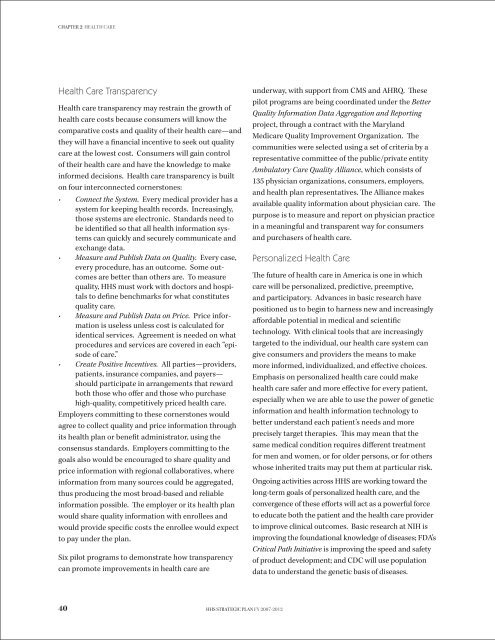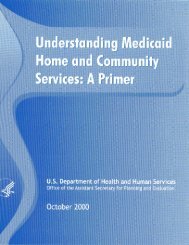STRATEGIC PLAN - ASPE - U.S. Department of Health and Human ...
STRATEGIC PLAN - ASPE - U.S. Department of Health and Human ...
STRATEGIC PLAN - ASPE - U.S. Department of Health and Human ...
Create successful ePaper yourself
Turn your PDF publications into a flip-book with our unique Google optimized e-Paper software.
CHAPTER 2: <strong>Health</strong> care<strong>Health</strong> Care Transparency<strong>Health</strong> care transparency may restrain the growth <strong>of</strong>health care costs because consumers will know thecomparative costs <strong>and</strong> quality <strong>of</strong> their health care—<strong>and</strong>they will have a financial incentive to seek out qualitycare at the lowest cost. Consumers will gain control<strong>of</strong> their health care <strong>and</strong> have the knowledge to makeinformed decisions. <strong>Health</strong> care transparency is builton four interconnected cornerstones:• Connect the System. Every medical provider has asystem for keeping health records. Increasingly,those systems are electronic. St<strong>and</strong>ards need tobe identified so that all health information systemscan quickly <strong>and</strong> securely communicate <strong>and</strong>exchange data.• Measure <strong>and</strong> Publish Data on Quality. Every case,every procedure, has an outcome. Some outcomesare better than others are. To measurequality, HHS must work with doctors <strong>and</strong> hospitalsto define benchmarks for what constitutesquality care.• Measure <strong>and</strong> Publish Data on Price. Price informationis useless unless cost is calculated foridentical services. Agreement is needed on whatprocedures <strong>and</strong> services are covered in each “episode<strong>of</strong> care.”• Create Positive Incentives. All parties—providers,patients, insurance companies, <strong>and</strong> payers—should participate in arrangements that rewardboth those who <strong>of</strong>fer <strong>and</strong> those who purchasehigh-quality, competitively priced health care.Employers committing to these cornerstones wouldagree to collect quality <strong>and</strong> price information throughits health plan or benefit administrator, using theconsensus st<strong>and</strong>ards. Employers committing to thegoals also would be encouraged to share quality <strong>and</strong>price information with regional collaboratives, whereinformation from many sources could be aggregated,thus producing the most broad-based <strong>and</strong> reliableinformation possible. The employer or its health planwould share quality information with enrollees <strong>and</strong>would provide specific costs the enrollee would expectto pay under the plan.Six pilot programs to demonstrate how transparencycan promote improvements in health care areunderway, with support from CMS <strong>and</strong> AHRQ. Thesepilot programs are being coordinated under the BetterQuality Information Data Aggregation <strong>and</strong> Reportingproject, through a contract with the Maryl<strong>and</strong>Medicare Quality Improvement Organization. Thecommunities were selected using a set <strong>of</strong> criteria by arepresentative committee <strong>of</strong> the public/private entityAmbulatory Care Quality Alliance, which consists <strong>of</strong>135 physician organizations, consumers, employers,<strong>and</strong> health plan representatives. The Alliance makesavailable quality information about physician care. Thepurpose is to measure <strong>and</strong> report on physician practicein a meaningful <strong>and</strong> transparent way for consumers<strong>and</strong> purchasers <strong>of</strong> health care.Personalized <strong>Health</strong> CareThe future <strong>of</strong> health care in America is one in whichcare will be personalized, predictive, preemptive,<strong>and</strong> participatory. Advances in basic research havepositioned us to begin to harness new <strong>and</strong> increasinglyaffordable potential in medical <strong>and</strong> scientifictechnology. With clinical tools that are increasinglytargeted to the individual, our health care system cangive consumers <strong>and</strong> providers the means to makemore informed, individualized, <strong>and</strong> effective choices.Emphasis on personalized health care could makehealth care safer <strong>and</strong> more effective for every patient,especially when we are able to use the power <strong>of</strong> geneticinformation <strong>and</strong> health information technology tobetter underst<strong>and</strong> each patient’s needs <strong>and</strong> moreprecisely target therapies. This may mean that thesame medical condition requires different treatmentfor men <strong>and</strong> women, or for older persons, or for otherswhose inherited traits may put them at particular risk.Ongoing activities across HHS are working toward thelong-term goals <strong>of</strong> personalized health care, <strong>and</strong> theconvergence <strong>of</strong> these efforts will act as a powerful forceto educate both the patient <strong>and</strong> the health care providerto improve clinical outcomes. Basic research at NIH isimproving the foundational knowledge <strong>of</strong> diseases; FDA’sCritical Path Initiative is improving the speed <strong>and</strong> safety<strong>of</strong> product development; <strong>and</strong> CDC will use populationdata to underst<strong>and</strong> the genetic basis <strong>of</strong> diseases.40 HHS Strategic Plan FY 2007-2012
















